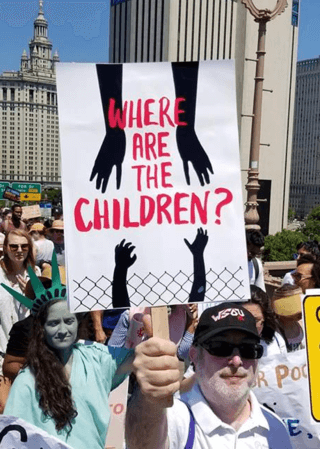The Agony Children Experience When Separated from Parents
The kids are not alright.

What happens when children are separated from their parents against their will? What trauma results and what is the impact on a child’s well being?
The news is filled with heartbreaking images of children and families torn apart. To understand the impact of these events, I sat down with Edith Goldenhar, a writer, and nonprofit strategist, especially for organizations focused on early childhood education. Here’s what she had to say:
“It is true that family separation occurs in many contexts, including military obligations, serious illness, and rigorous work schedules. Our social service system regularly removes children from homes deemed unfit. And throughout history, mass migrations have flung parents and children far apart, across multiple borders and stormy seas. What we are witnessing today at the border is very different.”
The stated intention of separating children from their families through the “zero tolerance” policy was to inflict this harm on children as a deterrent. The chaos of its implementation and dismantling lays bare the ignorance of healthy child development. When federal judge Dana M. Sabraw ordered the administration to reunite families within 30 days, he described the situation as so “outrageous” and “offensive” and “as to shock the contemporary conscience.”
Pediatrician and researcher Dr. Nadine Burke Harris’ opinion about such forced parent-child separation is unequivocal: “Without a nurturing parent or caregiver, the child’s biological stress response stays on, leading to changes in brain architecture, weakening of the immune system, and impairment of hormonal levels.” (See “How Childhood Trauma Affects Health Across a Lifetime.”)
It should be no surprise that parental separation ranks high on the index of Adverse Childhood Experiences. Toxic stress may not be remembered, but its effects last a lifetime – through heart disease, substance abuse, diabetes, and mental illness – and has been proven to shorten lives by as much as twenty years. Furthermore, hundreds of studies document additional long-term health risks of toxic stress on infants and toddlers.
How did this all begin?
For six weeks in May and June, the Justice Department treated all migrants and asylum-seekers on our southwestern border of the United States as lawbreakers, detaining them in cages on the Rio Grande border and delivering their children elsewhere. After images and piercing sounds of sobbing toddlers flooded the 24-hour news stream, an executive order was signed by the president to end family separation. The new policy incarcerates parents and children together while their cases are adjudicated.
Is the crisis over?
Absolutely not. Most of the 2300 children remain interned in abandoned Wal-Marts, tent cities, and “tender age shelters” across seventeen states. To date, there is no government plan despite a federal court order requiring reunification. Far from muting public outcry, the Administration’s behavior ignited more than 700 rallies and marches in all 50 states, with tens of thousands insisting that “families belong together.” (See: New Lawsuit Challenges Family Separation.)
This situation is chilling for me, the daughter of Holocaust survivors from Belgium. During World War II, thousands of Belgian Jewish parents, having no other alternative, entrusted their children to Resistance fighters and courageous citizens who transferred them to Christian families, monasteries, and convents. Most of Belgium’s hidden children survived. Many of their parents perished.
My mother was also fortunate in being hidden with her mother. She never failed to mention that ongoing, intimate bond as the key to her emotional resilience. When she attended the first-ever Conference of Hidden Children in New York in 1991, a gathering of 1600, she witnessed the suffering of adults whose lives had been saved by wrenching them from their families. People pinned notes to bulletin boards, seeking any shred of memory about their mothers and fathers. Those who had reunited with a surviving parent spoke of walled-off emotions, being unable to rekindle former affections.
Even my optimistic mother struggled in the aftermath, quarreling often with her father, who had been hidden elsewhere and emerged as a bitter man. But her battles paled next to testimonies about decades of guilt, grief, eating disorders, alcoholism, and all the signs of what we now call post-traumatic stress disorder. (See: “Hidden Children Speak Out on Border Separations.”)
How can a parent do to help?
Our country already has damaged more than 2,000 lives and bears that responsibility. To hope for the best is to hide from the truth. Insist on the protection of asylum-seeking families as enshrined in U.S. and international law. Join a demonstration. Write to your legislator. Volunteer or donate to organizations providing psychological and legal services. You can help make compassion the cornerstone of American immigration policy.


